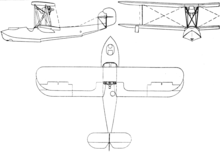Canadian Vickers Vedette
| Canadian Vickers Vedette | |
|---|---|

|
|
| Type: | Flying boat |
| Design country: | |
| Manufacturer: | |
| First flight: |
November 4, 1924 |
| Production time: |
until 1930 |
| Number of pieces: |
60 |
The Canadian Vickers Vedette ("outpost") was a biplane designed flying boat made by the Canadian manufacturer Canadian Vickers . It was the first aircraft designed and built in Canada, and it suited the country's special conditions. The Vedette was commissioned by the Royal Canadian Air Force (RCAF) as a smaller counterpart to the Vickers Viking , mainly to be used in forest protection. Most of the country's topographic maps are based on photographs taken with one of these aircraft.
draft
The Canadian Vickers Vedette was equipped with two to three seats and was propelled by a pusher propeller. The design was created in early 1924 and came from the British designer R. K. Pierson. The prototype Vedette I had a Rolls-Royce Falcon III engine and made its maiden flight on November 4, 1924 . Later the Wolseley Viper , Wright J-4 and Armstrong Siddeley Lynx engines were installed for test purposes .
Several variants of the Vedette were created, including two versions designed as amphibious aircraft and one type with an all-metal fuselage. The wooden hulled machines often had to deal with leaks. By 1930, a total of 60 copies of all variants had been produced.
Several successor models were based on the Vedette, such as the Vista monoplane , the twin-engine Varuna and Vancouver and the Vanessa floatplane .
commitment
The first production model served the Fairchild Aerial Surveys as a survey aircraft. Most of the aircraft built came into the possession of the RCAF. One of the most important tasks was the photographic land surveying in previously unmapped parts of the country. This work, which was interrupted at the beginning of the Second World War, was completed after the end of the war by more modern aircraft. The RCAF and Western Canada Airways aircraft stationed on the coast were used for fisheries protection and anti-smuggling .
The RCAF acquired a Wright J-4 motorized Vedette I in 1925 and 18 Armstrong-Siddeley Lynx IV- powered Vedette IIs in the following years . These machines were decommissioned before World War II. From 1929, the RCAF received thirteen Vedette Vs with a higher takeoff weight and eleven improved Vedette VAs. A single Vedette VI with a Wright J-6 engine had a metal fuselage and an enclosed cockpit. Later a Vedette V was converted and also equipped with a metal hull.
The governments of the provinces of Ontario , Manitoba and Saskatchewan procured several vedette to use to search for forest fires.
Six Vedette Vs with Wright J-5 engines went to Chile , where they were used to set up an air link between Santiago and Puerto Montt .
Users
-
 Canada
Canada
- Royal Canadian Air Force (45)
- Fairchild Aerial Surveys (1)
- Manitoba (Government) Air Service (7)
- Ontario Provincial Air Service (2)
- Saskatchewan Government (5)
- Western Canada Airways (1)
- Canadian Airways (1)
Versions
- Vedette I - prototype equipped with Rolls-Royce Falcon III , Wolseley Viper , Wright J-4 and Armstrong Siddeley Lynx engines in succession
- Vedette II - production model with improved tail unit and small changes
- Vedette III & IV - planned transport options
- Vedette V - amphibious aircraft, only partially delivered with wheels
- Vedette Va - Vedette V with improved slats
- Vedette Vam - converted Vedette V with metal hull
- Vedette VI - variant with metal fuselage and improved slats
- Vassal I - planned version with improved wings
Technical specifications
| Parameter | Data Vedette II |
|---|---|
| crew | 2-3 |
| length | 10.00 m |
| span | 12.80 m |
| height | 3.40 m |
| payload | ? kg |
| Empty mass | 882 kg |
| Takeoff mass | 1816 kg |
| Top speed | 153 km / h |
| Service ceiling | 3960 m |
| Engines | 1 × Wright J-4 or Wright J-5 or Armstrong-Siddeley Lynx IV |
